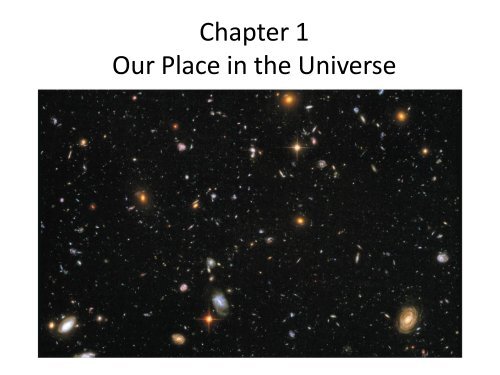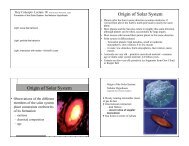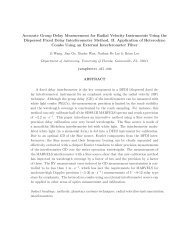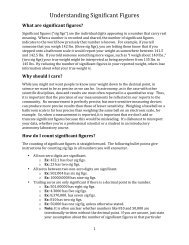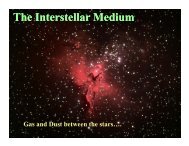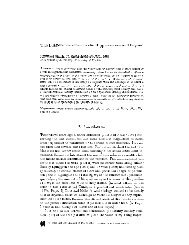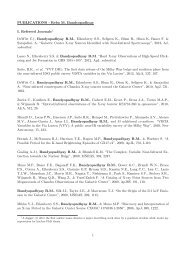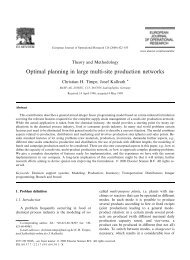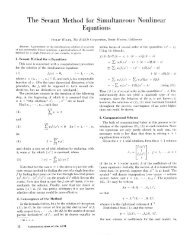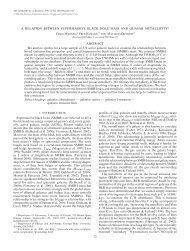Chapter 1 Our Place in the Universe - Astronomy
Chapter 1 Our Place in the Universe - Astronomy
Chapter 1 Our Place in the Universe - Astronomy
You also want an ePaper? Increase the reach of your titles
YUMPU automatically turns print PDFs into web optimized ePapers that Google loves.
<strong>Chapter</strong> 1<br />
<strong>Our</strong> <strong>Place</strong> <strong>in</strong> <strong>the</strong> <strong>Universe</strong>
1.1 <strong>Our</strong> Modern View of <strong>the</strong><br />
<strong>Universe</strong><br />
Topics we will explore:<br />
• What is our place <strong>in</strong> <strong>the</strong> universe?<br />
• How did we come to be?<br />
• How can we know what <strong>the</strong> universe was like <strong>in</strong> <strong>the</strong><br />
past?<br />
• Can we see <strong>the</strong> entire universe?<br />
• First, let’s take a look to some basic astronomical<br />
objects
Solar System<br />
(<strong>in</strong> general planetary system)<br />
A star, <strong>in</strong> our case <strong>the</strong> Sun and all <strong>the</strong> material that orbits<br />
it, <strong>in</strong>clud<strong>in</strong>g its planets, moons, asteroids, comets, small<br />
bodies and gas and dust.
Star (Sun)<br />
A large, plasma sphere that generates heat and light through<br />
nuclear fusion <strong>in</strong> its core.<br />
In <strong>the</strong> case of <strong>the</strong> sun, it fuses hydrogen <strong>in</strong>to helium<br />
Plasma: Is a state of matter <strong>in</strong> which <strong>the</strong> matter is <strong>in</strong> ionized form. Composed<br />
of particles electrically charged. Normally composed of electrons (negative) and<br />
protons and ions (positive)
Planet<br />
Mars<br />
Neptune<br />
A moderately large object that orbits a star; it sh<strong>in</strong>es by<br />
reflect<strong>in</strong>g light from <strong>the</strong> star. The constitution of<br />
planets may be rocky, icy, or gaseous <strong>in</strong> composition.<br />
We will discuss <strong>the</strong> formal def<strong>in</strong>ition given by <strong>the</strong> IAU (International<br />
Astronomical Union) later <strong>in</strong> <strong>the</strong> semester
Moon (or Satellite)<br />
An object that orbits<br />
a planet<br />
Ganymede (orbits Jupiter)
Asteroid<br />
A relatively small and rocky object that<br />
orbits a star
Comet<br />
A relatively<br />
small and icy<br />
object that<br />
orbits a star
Nebula<br />
What is outside <strong>the</strong> solar system?<br />
An <strong>in</strong>terstellar cloud of<br />
gas and/or dust.<br />
Parts of a nebula may<br />
reflect light from a star<br />
(s), some part may<br />
emit light from exited<br />
gas atom by UV<br />
radiation from a star<br />
(s). Part may absorb<br />
light .<br />
(In <strong>the</strong> picture, <strong>the</strong> Orion<br />
nebula)<br />
The Orion nebula belongs to <strong>the</strong><br />
Milky way (our Galaxy)
Galaxy<br />
What is outside <strong>the</strong> Milky Way?<br />
A huge collection of stars <strong>in</strong> space, all held toge<strong>the</strong>r by gravity and<br />
orbit<strong>in</strong>g a common center. The Milky Way and <strong>the</strong> Andromeda galaxy<br />
are examples of galaxies<br />
M31, <strong>the</strong> great galaxy<br />
<strong>in</strong> Andromeda
Clusters of galaxies and<br />
superclusters<br />
• Groups of galaxies with more than a few<br />
dozen members are called galaxy clusters<br />
• Regions where galaxies and galaxy clusters are<br />
most tightly packed are called superclusters<br />
• Galaxy clusters and superclusters form giant<br />
cha<strong>in</strong>s and sheets with large voids between<br />
<strong>the</strong>m
<strong>Universe</strong><br />
The sum total of all matter and energy;<br />
that is, superclusters of galaxies, voids<br />
and everyth<strong>in</strong>g with<strong>in</strong> and between all<br />
galaxies
The observable <strong>Universe</strong><br />
• The portion of <strong>the</strong> universe than can be seen<br />
from Earth. The observable <strong>Universe</strong> is<br />
probably only a portion of <strong>the</strong> entire <strong>Universe</strong>
What is our place <strong>in</strong> <strong>the</strong> universe?
The Big Bang and <strong>the</strong> expand<strong>in</strong>g of <strong>the</strong> <strong>Universe</strong><br />
• Observations of galaxies show that <strong>the</strong> entire universe is expand<strong>in</strong>g, <strong>the</strong> average<br />
distance between galaxies is <strong>in</strong>creas<strong>in</strong>g with time.<br />
• This means that galaxies ( or at least matter) must have been close toge<strong>the</strong>r <strong>in</strong> <strong>the</strong><br />
past.<br />
• If we go back far enough, all <strong>the</strong> matter was concentrated <strong>in</strong> a small radius from<br />
which <strong>the</strong> expansion began.<br />
• That is called <strong>the</strong> Big Bang. From <strong>the</strong> rate of expansion it is estimated that it<br />
occurred about 14 billions year ago.<br />
• The universe has cont<strong>in</strong>ued to expand and evolve s<strong>in</strong>ce <strong>the</strong>n.<br />
• On a small scale, <strong>the</strong> force of gravity has drawn matter toge<strong>the</strong>r form<strong>in</strong>g galaxies,<br />
stars formed <strong>in</strong>side <strong>the</strong> galaxies and planets formed around some of those stars.<br />
• The only two chemical elements created dur<strong>in</strong>g <strong>the</strong> Big Bang were hydrogen and<br />
helium<br />
• The rest of <strong>the</strong> elements heavier than H and He are generated <strong>in</strong>side <strong>the</strong> stars<br />
• As Carl Sagan said: We are “star stuff”, all <strong>the</strong> chemical elements on our body came<br />
from stars
How did we come to be?
Let’s address <strong>the</strong> question: How can we know what<br />
<strong>the</strong> universe was like <strong>in</strong> <strong>the</strong> past?<br />
• Light travels at a f<strong>in</strong>ite speed (300,000 km/s).<br />
Dest<strong>in</strong>ation<br />
Moon<br />
Sun<br />
Sirius<br />
Andromeda Galaxy<br />
Light travel time<br />
1.2 second<br />
8 m<strong>in</strong>utes<br />
8 years<br />
2.5 million years
How can we know what <strong>the</strong> universe was like<br />
<strong>in</strong> <strong>the</strong> past?<br />
• Light travels at a f<strong>in</strong>ite speed (300,000 km/s).<br />
Dest<strong>in</strong>ation<br />
Moon<br />
Sun<br />
Sirius<br />
Andromeda Galaxy<br />
Light travel time<br />
1.2 second<br />
8 m<strong>in</strong>utes<br />
8 years<br />
2.5 million years<br />
Thus, we see objects as <strong>the</strong>y were <strong>in</strong> <strong>the</strong><br />
past:<br />
The far<strong>the</strong>r away we look <strong>in</strong> distance,<br />
<strong>the</strong> fur<strong>the</strong>r back we look <strong>in</strong> time.
The mean<strong>in</strong>g of a Light-Year<br />
• The distance light can travel <strong>in</strong> 1 year<br />
• About 10 trillion kilometers (10x10^12 km)<br />
or (6 trillion miles)
How far is a light-year?<br />
Distance = Speed x Time<br />
1light-year = (speed of light)<br />
(1 year)<br />
km 365 days 24 hr 60 m<strong>in</strong> 60 s<br />
= 300,000 s 1 yr 1 day 1 hr 1 m<strong>in</strong>
How far is a light-year?<br />
1light-year = (speed of light)<br />
(1 year)<br />
km 365 days 24 hr 60 m<strong>in</strong> 60 s<br />
= 300,000 s 1 yr 1 day 1 hr 1 m<strong>in</strong><br />
=9,460,000,000,000 km
Example:<br />
The distance to<br />
<strong>the</strong> Orion<br />
Nebula is about<br />
1500 light years.<br />
We see <strong>the</strong> Orion<br />
Nebula as it<br />
looked 1500<br />
years ago.
Example:<br />
This photo shows <strong>the</strong> Andromeda Galaxy as it looked<br />
about 2.5 million years ago.<br />
Question: When will<br />
we be able to see what<br />
it looks like now?
• At great distances, we see objects as <strong>the</strong>y were<br />
when <strong>the</strong> universe was much younger.<br />
We see a galaxy 7 billions light-years away as it was 7 billion<br />
years ago.<br />
Light from nearly 14 billion light years away shows <strong>the</strong><br />
universe as it looked shortly after <strong>the</strong> Big Bang, before galaxies<br />
existed
Can we see <strong>the</strong> entire universe?
Question<br />
Why can’t we see a galaxy 15 billion light-years away?<br />
(Assume <strong>the</strong> universe is 14 billion years old.)<br />
A. Because no galaxies exist at such a great<br />
distance.<br />
B. Galaxies may exist at that distance, but <strong>the</strong>ir<br />
light would be too fa<strong>in</strong>t for our telescopes to<br />
see.<br />
C. Because look<strong>in</strong>g 15 billion light-years away<br />
means look<strong>in</strong>g to a time before <strong>the</strong> universe<br />
existed.
Question<br />
Why can’t we see a galaxy 15 billion light-years away?<br />
(Assume <strong>the</strong> universe is 14 billion years old.)<br />
A. Because no galaxies exist at such a great<br />
distance.<br />
B. Galaxies may exist at that distance, but <strong>the</strong>ir<br />
light would be too fa<strong>in</strong>t for our telescopes to<br />
see.<br />
C. Because look<strong>in</strong>g 15 billion light-years away<br />
means look<strong>in</strong>g to a time before <strong>the</strong> universe<br />
existed.
What have we learned?<br />
• What is our physical place <strong>in</strong> <strong>the</strong> universe?<br />
– The Earth is a small planet <strong>in</strong> <strong>the</strong> solar system.<br />
– The solar system is one of many planetary systems <strong>in</strong> <strong>the</strong> Milky<br />
Way Galaxy<br />
– The Milky Way galaxy is one of about 40 galaxies <strong>in</strong> <strong>the</strong> Local<br />
Group of galaxies.<br />
– The Local Group is one a many groups <strong>in</strong> <strong>the</strong> Local Supercluster<br />
of galaxies<br />
• How did we come to be?<br />
– Part of <strong>the</strong> matter <strong>in</strong> our bodies came from <strong>the</strong> Big Bang, which<br />
produced hydrogen and helium.<br />
– All o<strong>the</strong>r elements were constructed from H and He <strong>in</strong> <strong>the</strong> core of<br />
<strong>the</strong> stars and <strong>the</strong>n recycled <strong>in</strong>to <strong>the</strong> <strong>in</strong>terstellar space from which<br />
new star systems were formed, <strong>in</strong>clud<strong>in</strong>g our solar system.
What have we learned?<br />
• How can we know what <strong>the</strong> universe was<br />
like <strong>in</strong> <strong>the</strong> past?<br />
– When we look to great distances, we are<br />
see<strong>in</strong>g events that happened long ago because<br />
light travels at a f<strong>in</strong>ite speed.<br />
• Can we see <strong>the</strong> entire universe?<br />
– No. The observable portion of <strong>the</strong> universe is<br />
about 14 billion light-years <strong>in</strong> radius because<br />
<strong>the</strong> universe is about 14 billion years old.
How big is Earth compared to our solar system?<br />
Let’s reduce <strong>the</strong> size of <strong>the</strong> solar system by a factor of 10<br />
billion; <strong>the</strong> Sun is now <strong>the</strong> size of a large grapefruit (14<br />
cm diameter).<br />
How big is Earth on this scale?<br />
A. an atom<br />
B. a ball po<strong>in</strong>t<br />
C. a marble<br />
D. a golf ball
Let’s reduce <strong>the</strong> size of <strong>the</strong> solar system by a factor of<br />
10 billion; <strong>the</strong> Sun is now <strong>the</strong> size of a large grapefruit<br />
(14 cm diameter).<br />
How big is Earth on this scale?<br />
A. an atom<br />
B. a ball po<strong>in</strong>t<br />
C. a marble<br />
D. a golf ball
<strong>Our</strong> Solar System - Sizes<br />
1 mile = 1.6 km<br />
Earth diameter =12,756 km = 1.28 x 10 4 km<br />
Jupiter diameter = 142,984 km = 1.43 x 10 5 km<br />
Sun diameter = 1,292,000 km = 1.292 x 10 6 km<br />
Diameter of Sun ~ 109 times diameter of Earth<br />
Diameter of Jupiter ~ 12 times diameter of Earth
The scale of <strong>the</strong> solar system<br />
• On a 1-to-10- billion<br />
scale:<br />
– The Sun is <strong>the</strong> size<br />
of a large<br />
grapefruit (14<br />
cm).<br />
– Earth is <strong>the</strong> size of<br />
a ball po<strong>in</strong>t, 15<br />
meters away.<br />
– The Earth is 8<br />
light-m<strong>in</strong>utes<br />
away from <strong>the</strong><br />
Sun
How far away are <strong>the</strong><br />
stars?<br />
On our 1-to-10-billion scale, it’s just a few m<strong>in</strong>utes’<br />
walk to Pluto.<br />
How far would you have to walk to reach Alpha<br />
Centauri (one of <strong>the</strong> closes start to <strong>the</strong> solar system)?<br />
(Alpha Centauri is 4.3 light-years away)<br />
A. 1 mile<br />
B. 10 miles<br />
C. 100 miles<br />
D. <strong>the</strong> distance across <strong>the</strong> United States<br />
(2500 miles)
Answer: D, <strong>the</strong> distance across <strong>the</strong><br />
United States
How big is <strong>the</strong> Milky Way Galaxy?<br />
The Milky Way has<br />
about 100 billion<br />
stars. Its diameter is<br />
about 100,000 light<br />
years<br />
On <strong>the</strong> same 1-to-10-<br />
billion scale, how big<br />
is <strong>the</strong> Milky Way?
Question<br />
Suppose you tried to count <strong>the</strong> more than 100 billion<br />
stars <strong>in</strong> our galaxy, at a rate of one per second.<br />
How long would it take you?<br />
A. a few weeks<br />
B. a few months<br />
C. a few years<br />
D. a few thousand years
Suppose you tried to count <strong>the</strong> more than 100 billion<br />
stars <strong>in</strong> our galaxy, at a rate of one per second.<br />
How long would it take you?<br />
A. a few weeks<br />
B. a few months<br />
C. a few years<br />
D. a few thousand years
How big is <strong>the</strong> universe?<br />
• The Milky Way is one of about 100 billion galaxies.<br />
• 10 11 stars/galaxy x 10 11 galaxies = 10 22 stars<br />
There are as many stars as gra<strong>in</strong>s of (dry) sand on all Earth’s beaches.
How do our lifetimes compare to <strong>the</strong> age<br />
of <strong>the</strong> universe?<br />
• The cosmic calendar: a scale on which we compress <strong>the</strong><br />
history of <strong>the</strong> universe <strong>in</strong>to 1 year.
What have we learned?<br />
• How big is Earth compared to our solar system?<br />
– The distances between planets are huge compared to<br />
<strong>the</strong>ir sizes—on a scale of 1-to-10-billion, Earth is <strong>the</strong><br />
size of a ball po<strong>in</strong>t and <strong>the</strong> Sun is 15 meters away.<br />
• How far away are <strong>the</strong> stars?<br />
– On <strong>the</strong> same scale, <strong>the</strong> stars are thousands of<br />
kilometers away.<br />
• How big is <strong>the</strong> Milky Way Galaxy?<br />
– It would take more than 3000 years to count <strong>the</strong> 100<br />
billion stars <strong>in</strong> <strong>the</strong> Milky Way Galaxy at a rate of one<br />
per second, and <strong>the</strong>y are spread across 100,000 lightyears.
What have we learned?<br />
• How big is <strong>the</strong> universe?<br />
– The observable universe is 14 billion lightyears<br />
<strong>in</strong> radius and conta<strong>in</strong>s over 100 billion<br />
galaxies with a total number of stars<br />
comparable to <strong>the</strong> number of gra<strong>in</strong>s of sand<br />
on all of Earth’s beaches.<br />
• How do our lifetimes compare to <strong>the</strong> age of <strong>the</strong><br />
universe?<br />
– On a cosmic calendar that compresses <strong>the</strong><br />
history of <strong>the</strong> universe <strong>in</strong>to 1 year, human<br />
civilization is just a few seconds old, and a<br />
human lifetime is a fraction of a second.
1.3 Spaceship Earth<br />
Let’s explore <strong>the</strong>se topics:<br />
• How is Earth mov<strong>in</strong>g <strong>in</strong> our solar system?<br />
• How is our solar system mov<strong>in</strong>g <strong>in</strong> <strong>the</strong> Milky Way<br />
Galaxy?<br />
• How do galaxies move with<strong>in</strong> <strong>the</strong> universe?<br />
• Are we ever sitt<strong>in</strong>g still?
How is Earth mov<strong>in</strong>g <strong>in</strong> our solar system?<br />
• Contrary to our perception, we are not “sitt<strong>in</strong>g still.”<br />
• We are mov<strong>in</strong>g with Earth <strong>in</strong> several ways, and at<br />
surpris<strong>in</strong>gly fast speeds.<br />
The Earth rotates<br />
around its axis once<br />
every day.
How can we calculate <strong>the</strong> speed of a person<br />
located at <strong>the</strong> equator due to earth rotation?<br />
• Rotation speed at equator = equatorial circumference/length of day<br />
(Remember that Speed = Distance/Time)<br />
The Earth’s equatorial radius is 6378 km<br />
The circumference is 2 x Pi x radius = 2 x 3.1416 x 6378 = 40,074 km<br />
One day is equal to 24 hours<br />
Rotation speed at equator = 40,074/24 = 1670 km/hr
Earth orbits <strong>the</strong> Sun (revolves) once every year<br />
• The time it takes <strong>the</strong> Earth to complete one orbit around <strong>the</strong> Sun is called <strong>the</strong> orbital<br />
period ( ~365 days)<br />
•The average distance between <strong>the</strong> Earth and <strong>the</strong> Sun is 1 AU ≈ 150 million kilometers.<br />
(AU:Astronomical Unit, <strong>the</strong> mean distance between <strong>the</strong> Earth and <strong>the</strong> Sun)<br />
• The Earth orbit <strong>the</strong> Sun at an average speed of 107,000 km/hr<br />
• With Earth’s axis tilted by 23.5º (po<strong>in</strong>t<strong>in</strong>g to close to Polaris)<br />
It rotates <strong>in</strong> <strong>the</strong> same direction it orbits, counterclockwise as viewed from above <strong>the</strong><br />
North Pole.<br />
The Earth orbital path def<strong>in</strong>es a flat plane called <strong>the</strong> Ecliptic. The ecliptic is also <strong>the</strong><br />
apparent path of <strong>the</strong> Sun <strong>in</strong> <strong>the</strong> celestial sphere
How is our Sun mov<strong>in</strong>g <strong>in</strong> <strong>the</strong> Milky Way Galaxy?<br />
<strong>Our</strong> Sun moves relative to nearby stars <strong>in</strong> <strong>the</strong> local solar<br />
neighborhood…<br />
•At typical relative speeds of more than 70,000 km/hr<br />
• but stars are so far away that we cannot easily notice<br />
<strong>the</strong>ir motion<br />
The Sun is located at about<br />
28,000 light-years from <strong>the</strong><br />
center of <strong>the</strong> Milky Way<br />
… and <strong>the</strong> Sun orbits <strong>the</strong><br />
galaxy every 230 million<br />
years.<br />
The speed at which our solar<br />
system rotates around <strong>the</strong><br />
center of <strong>the</strong> galaxy is about<br />
800,000 km/hr
More detailed study of <strong>the</strong> Milky Way’s rotation reveals<br />
one of <strong>the</strong> greatest mysteries <strong>in</strong> astronomy:<br />
Most of <strong>the</strong> galaxy’s light comes from stars and gas <strong>in</strong> <strong>the</strong> galactic<br />
disk and central bulge<br />
But measurements suggest that most of <strong>the</strong> mass lies unseen <strong>in</strong> <strong>the</strong><br />
spherical halo that surrounds <strong>the</strong> entire disk<br />
This reveals <strong>the</strong> presence of a mass that we cannot see. It is called dark matter
How do galaxies move with<strong>in</strong> <strong>the</strong> universe?<br />
Galaxies are carried along with <strong>the</strong> expansion of <strong>the</strong> universe. But<br />
how did Hubble figure out that <strong>the</strong> universe is expand<strong>in</strong>g?<br />
The analogy of <strong>the</strong> rais<strong>in</strong> cake:
The analogy of <strong>the</strong> rais<strong>in</strong>g cake<br />
• A rais<strong>in</strong> that was at 1 cm, after bak<strong>in</strong>g for one hour is at 3 cm<br />
It moves at a speed of 2 cm/hr<br />
• Ano<strong>the</strong>r rais<strong>in</strong>g that was at 2 cm, after bak<strong>in</strong>g for one hour is<br />
at 6 cm<br />
It moves at a speed of 4 cm/hr<br />
The more distant <strong>the</strong> rais<strong>in</strong>s are, <strong>the</strong>y move at larger speed.
Edw<strong>in</strong> Hubble discovered <strong>in</strong> <strong>the</strong> 1920’s by measur<strong>in</strong>g<br />
<strong>the</strong> velocity and distance of galaxies that:<br />
• All galaxies outside our Local Group are<br />
mov<strong>in</strong>g away from us.<br />
• The more distant <strong>the</strong> galaxy, <strong>the</strong> faster it is<br />
rac<strong>in</strong>g away.
Hubble plotted <strong>the</strong> velocity and <strong>the</strong> distance of <strong>the</strong> galaxies.<br />
It gives a l<strong>in</strong>ear relationship between <strong>the</strong> two parameters.<br />
It is called <strong>the</strong> Hubble law<br />
Conclusion: We live <strong>in</strong> an expand<strong>in</strong>g universe.
Are we ever sitt<strong>in</strong>g still?
What have we learned?<br />
• How is Earth mov<strong>in</strong>g <strong>in</strong> our solar system?<br />
– It rotates on its axis once a day (24 hours) and<br />
orbits <strong>the</strong> Sun <strong>in</strong> ~365 days at a distance of 1<br />
AU = 150 million kilometers.<br />
• How is our solar system mov<strong>in</strong>g <strong>in</strong> <strong>the</strong> Milky<br />
Way Galaxy?<br />
– Stars <strong>in</strong> <strong>the</strong> Local Neighborhood move<br />
randomly relative to one ano<strong>the</strong>r and orbit<br />
<strong>the</strong> center of <strong>the</strong> Milky Way <strong>in</strong> about 230<br />
million years.
What have we learned?<br />
• How do galaxies move with<strong>in</strong> <strong>the</strong> universe?<br />
– All galaxies beyond <strong>the</strong> Local Group are<br />
mov<strong>in</strong>g away from us with <strong>the</strong> expansion of<br />
<strong>the</strong> universe: <strong>the</strong> more distant <strong>the</strong>y are, <strong>the</strong><br />
faster <strong>the</strong>y’re mov<strong>in</strong>g.<br />
• Are we ever sitt<strong>in</strong>g still?<br />
– The answer is No! Earth is constantly <strong>in</strong><br />
motion, even though we don’t notice it.


